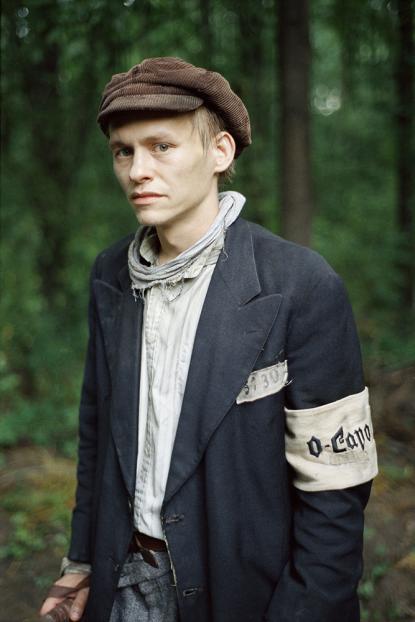2024. May 8. Wednesday
Hungarian Photographers - Budapest
|
|
Address: 1065, Budapest Nagymező utca 20.
Phone number: (1) 473-2666
E-mail: maimano@maimano.hu
Opening hours: Mon-Sun 11-19
|
The exhibition has closed for visitors.
2015.11.22. - 2016.01.03.
Ticket prices
|
Individual ticket for adults
|
1500 HUF
|
|
|
Group ticket for adults
|
900 HUF
|
|
|
Individual ticket for students
|
700 HUF
|
|
|
Group ticket for students
|
450 HUF
|
|
|
Individual ticket for pensioners
|
700 HUF
|
|
|
Group ticket for pensioners
|
450 HUF
|
|
|
Ticket for families
|
3000 HUF
|
Photographer Ildi Hermann took portraits of the cast – including both the international actors and the extras – on the set of the movie Son of Saul based on the concept of László Nemes, director and Mátyás Erdély, cinematographer. These photographs were taken during idle times, between takes, within strange confines. The actors are not in character; neither have they left the role behind them, nor has the role escaped them yet. Their own selves and their film persona look into the camera as one. As such, the portraits open the door to the past – the reality defined by the characters, – at the same time, however, they also exist in the constructed world of the movie. Their distinct power stems from the artistic immortalization of this duality.

The exhibition of thirty-one, almost life-size portraits is complemented by three archive shots, the negatives of which are stored in the collection of Auschwitz-Birkenau Memorial and State Museum. In one of the scenes in the movie, one member of the Sonderkommando takes these similar shots with a camera through a door and later hides them – this is how it happened in reality in the summer of 1944. One of these archive shots actually appears as a still image in the movie.
The exhibition features excerpts from texts written and hidden by prisoners and members of the Sonderkommando in Auschwitz. “Dear Finder, look everywhere, in every single pile of dirt. Such documents have been buried here by the dozen – mine as well as others. These will shed light on everything that happened here.”
The starting point for creating these photographs was the photo album The Great Terror 1937-1938. The volume contains deeply moving images taken of people sentenced to death, often just a few hours before their execution. Polish photographer Tomasz Kizny worked on this project for three years and produced a landmark album that explores this dark period of 20th-century history.
The exhibition renders portraits taken during the shooting, archival footage, and original text into a unit, both directly and indirectly reflecting on the film. The photographs were shot on 35mm film, just like the movie. The movie’s nature of immediately and inexorably pulling in the viewers to the story and making them part of the events is also present in the exhibition. The portraits surround the visitors like reflections, not allowing the viewer to opt out or to avoid confrontation.
Mai Manó House has created an important project by presenting Ildi Hermann’s photographs. Compiled by Gabriella Csizek, curator, the exhibition material of portraits, archival footage, and accompanying documents will be showcased worldwide after Budapest, allowing in-depth remembrance and contributing to the local as well as global recognition of the movie with the tools of photography.
Gabriella Csizek, curator

The exhibition of thirty-one, almost life-size portraits is complemented by three archive shots, the negatives of which are stored in the collection of Auschwitz-Birkenau Memorial and State Museum. In one of the scenes in the movie, one member of the Sonderkommando takes these similar shots with a camera through a door and later hides them – this is how it happened in reality in the summer of 1944. One of these archive shots actually appears as a still image in the movie.
The exhibition features excerpts from texts written and hidden by prisoners and members of the Sonderkommando in Auschwitz. “Dear Finder, look everywhere, in every single pile of dirt. Such documents have been buried here by the dozen – mine as well as others. These will shed light on everything that happened here.”
The starting point for creating these photographs was the photo album The Great Terror 1937-1938. The volume contains deeply moving images taken of people sentenced to death, often just a few hours before their execution. Polish photographer Tomasz Kizny worked on this project for three years and produced a landmark album that explores this dark period of 20th-century history.
The exhibition renders portraits taken during the shooting, archival footage, and original text into a unit, both directly and indirectly reflecting on the film. The photographs were shot on 35mm film, just like the movie. The movie’s nature of immediately and inexorably pulling in the viewers to the story and making them part of the events is also present in the exhibition. The portraits surround the visitors like reflections, not allowing the viewer to opt out or to avoid confrontation.
Mai Manó House has created an important project by presenting Ildi Hermann’s photographs. Compiled by Gabriella Csizek, curator, the exhibition material of portraits, archival footage, and accompanying documents will be showcased worldwide after Budapest, allowing in-depth remembrance and contributing to the local as well as global recognition of the movie with the tools of photography.
Gabriella Csizek, curator


